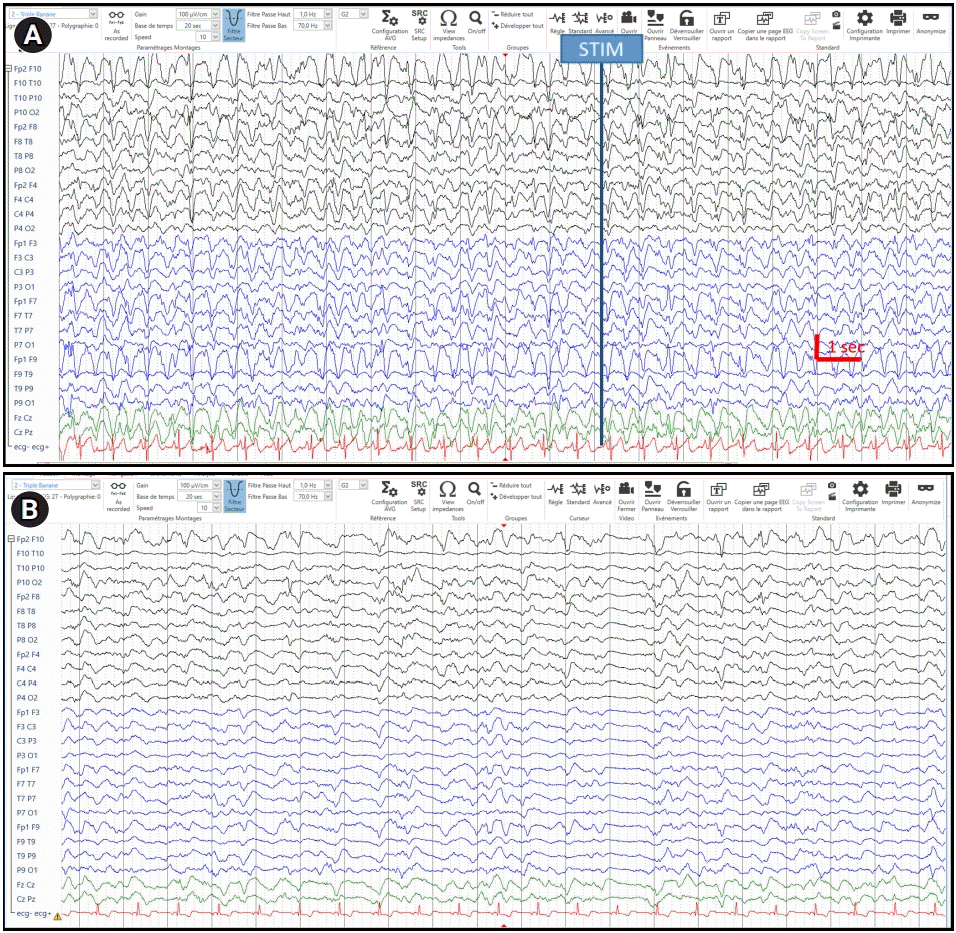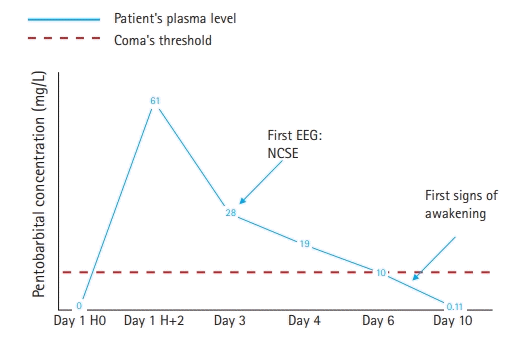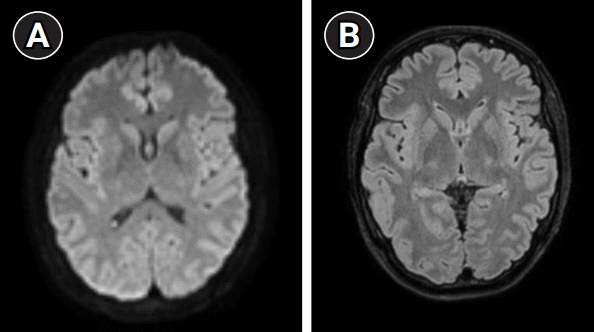Abstract
Case Report
We reported a case of barbiturate poisoning in a 28-year-old woman who recovered from lethal pentobarbital deliberate self-poisoning. The initial blood pentobarbital concentration was 61 mg/L, corresponding to a potentially lethal dose. Despite the ingestion of a high dose of pentobarbital, the electroencephalogram revealed an unattended pattern compatible with possible nonconvulsive status epilepticus. Following resuscitation maneuvers, appropriate care, and antiseizure medication, the patient awakened after 7 days. The evolution was excellent without neurological deficits at 2 months.
Conclusion
Despite the expected and known effects of high-dose pentobarbital in reducing and suppressing cortical activity in the brain, the present case demonstrates that lethal dose of pentobarbital may have an epileptogenic effect. Our hypothesis was that the mechanism of the origin of such a picture is a relatively abrupt decrease in toxic doses of pentobarbital, resulting in a withdrawal phenomenon.
Barbiturates, derivatives of barbituric acid, are chemically synthesized substances used as drugs. Owing to their mechanisms of action, they perform hypnotic, sedative, antiseizure, and anesthetic activities. Barbiturates act on gamma aminobutyric acid (GABA-A) receptors in a dose-dependent manner by increasing the open time of the chloride ion channel, which involves postsynaptic hyperpolarization and central nervous system (CNS) depression. GABA is the main inhibitory neurotransmitter in the CNS and reduces neuronal activity [1]. Owing to severe side-effects, the use of barbiturates has decreased over time. Their therapeutic indications are circumscribed, particularly in cases of refractory and super-refractory status epilepticus (SE) [2] or refractory intracranial hypertension after head trauma.
Currently, pentobarbital is mainly used by veterinarians (anesthesia and euthanasia) or for end-of-life procedures (lethal injection in the United States or assisted suicide in Belgium and Switzerland [3]). Currently, its use in suicide attempts is rare, although recent cases have shown an increase in the popularity of pentobarbital poisoning as a peaceful suicide method [4]. Here, we report a case of phenobarbital self-poisoning complicated by cardiac arrest (CA) and unexpected acute nonconvulsive SE (NCSE) in a 28-year-old woman who recovered.
A 28-year-old woman with a history of depression ingested potentially lethal doses of pentobarbital with suicidal intent and sent a goodbye message to her family. She was found by her family members unconscious, pulseless, and cardiopulmonary resuscitation (CPR) was started.
The rescue team arrived 10 minutes after the alarm (20–30 minutes post-ingestion) and found the patient with pulseless electrical activity, CA, and bilateral mydriasis. CPR was resumed using manual compression and endotracheal intubation. She received 1 mg of epinephrine every 3–5 minutes, as recommended by advanced cardiac life support guidelines, 0.5 mg of naloxone, and 0.4 mg of flumazenil with a return of spontaneous circulation after 20 minutes (40–50 minutes after intake). During transportation to the hospital, supplementary doses of epinephrine were administered.
On arrival at the emergency department, the patient remained deeply comatose (Glasgow Coma Scale [GCS] score, 3/15) with bilateral nonreactive mydriasis without sedatives. She was hypothermic (33 °C). Her heart rate was 84 bpm, and blood pressure was 84/52 mm Hg on norepinephrine infusion. The electrocardiogram revealed no conduction or re-polarization abnormalities. The initial laboratory test showed lactic acidosis (arterial blood gas analysis: pH, 7.32; partial pressure of carbon dioxide, 4.56 kPa; partial pressure of oxygen, 30.2 kPa; HCO3, 17 mmol/L; lactate, 4.417 mmol/L; and hypokalemia, 2.6 mmol/L), without organ failure. Toxicology tests were positive only for barbiturates, and an advanced analysis performed at the forensic laboratory using gas chromatography-mass spectrometry was positive for pentobarbital. The initial concentration was 61 mg/L, well above the therapeutic target value (approximately 1–3 mg/L) and within the range of values observed in deaths following massive pentobarbital use (approximately 10–169 mg/L) [5].
Cerebral computed tomography angiography performed as an initial workup revealed mild brain edema and normal perfusion. Charcoal treatment via a nasogastric tube was initiated immediately to limit barbiturate absorption, and the patient was transferred to the intensive care unit (ICU). On day 1, she developed diabetes insipidus, which was treated with desmopressin.
From days 1 to 3, she developed a vasoplegic shock requiring vasopressor support with norepinephrine (maximum dose, 0.32 µg/kg/min), hydrocortisone (200 µg/24 hr), and fluid resuscitation (approximately 11 L). As kidney function was normal, renal replacement therapy (RRT) was not initiated. Supportive care consisted of charcoal treatment (three times in total) and urine alkalinization. The patient received 100 mL of sodium bicarbonate (8.4%) twice to maintain a urinary pH >7.5. On day 3, because of persistent coma, the patient underwent continuous electroencephalogram (cEEG) monitoring, which showed a pattern in the ictal-interictal continuum compatible with possible NCSE [6,7] (Fig. 1A). Antiseizure medications (clonazepam 1 mg, levetiracetam 40 mg/kg, and lacosamide 8 mg/kg) were started, with EEG improvement after 36 hours (Fig. 1B); however, no clinical improvement was observed before day 7. The pentobarbital level was 28 mg/L during NCSE (>50% reduction from day 1). Fig. 2 shows the kinetics of pentobarbital blood concentrations during the ICU stay.
To exclude hypoxic–ischemic encephalopathy as a potential cause of NCSE, a complete neuroprognostic assessment was performed. Brain magnetic resonance imaging performed on day 4 from intoxication revealed no abnormalities (Fig. 3). Somatosensory evoked potentials were bilaterally preserved with normal voltage (left, 2.02 µV; right, 2.82 µV) and neuron-specific enolase was at 5.5 µg/L. Therefore, we excluded the contribution of hypoxic ischemia. Favorable evolution on EEG (only mild encephalopathy on day 5) allowed the reduction in clonazepam; because of an allergic reaction to levetiracetam, the latter was stopped, and lacosamide was increased.
On day 7, the patient showed the first signs of awakening. On day 8, the GCS score was 15/15, and she was extubated. On day 9, the patient was transferred to a mixed medical and psychiatric unit. The EEG activity returned to normal on day 10 without signs of encephalopathy. The patient’s neurological evolution was excellent, and she was discharged from the hospital after 1 month. Antiseizure treatment was gradually tapered and fully stopped after a normal follow-up (clinical examination and routine EEG) 2 months after intoxication.
Voluntary poisoning with pentobarbital is rare because this molecule is no longer used in human medicine, except for assisted suicide. However, it is still used by veterinarians to euthanize animals. It is a short-acting weak-acid barbiturate used as an anticonvulsant, hypnotic, induction and sedative agent. It has a rapid onset of action, between 10 and 60 minutes after oral absorption. Its plasma half-life is 15–50 hours and is dose-dependent. It has high lipid solubility and is metabolized by the liver and excreted in the urine as an inactive metabolite, with negligible renal excretion (<1%). Blood levels range between 1 and 4 mg/L within 30 minutes to 2 hours after oral absorption of 100–600 mg of pentobarbital [5]; blood levels are considered toxic at 5 mg/L or more and lethal from 10 to 169 mg/L. Barbiturates act on GABA-A receptors and reduce neuronal activity. Pentobarbital overdose classically leads to impaired consciousness and coma, mimicking the features of brain death. It can also lead to airway compromise, cardiovascular collapse, respiratory depression, CA, or even death [5,8]. The patient described here presented with pentobarbital levels in the lethal range on day 1, which persisted at toxic and potentially fatal values until day 6 (Fig. 2).
Pentobarbital poisoning is mainly managed by supportive care, including invasive mechanical ventilation, fluid loading, vasopressors, and CPR in most severe cases. Currently, no specific antidotes for barbiturates exist. The therapeutic procedures that may enhance barbiturate elimination are debatable. Although multiple dose activated charcoal may be useful for most phenobarbital poisonings to reduce the duration of intubation and mechanical ventilation, it plays no role in urine alkalinization. RRT appears to enhance elimination; however, clinical benefits relative to potential complications and costs are poorly defined. Activated charcoal was administered in accordance with the recommendations of American and European toxicological societies. RRT was not an option, because pentobarbital is a short-acting barbiturate [9].
On day 3, the patient presented an EEG pattern in the ictal-interictal continuum compatible with possible NCSE in coma and was treated successfully with escalation of antiseizure medications, as recommended by the guidelines of SE [2]. Such EEG pattern was unexpected, as these molecules usually shut down synaptic and metabolic activities in the brain, producing a suppressed or suppression-burst pattern on the EEG [10]. Barbiturates are well-established treatments for refractory and super-refractory SE [2]. Our patient did not present with a suppressed, suppression-burst, or discontinuous background. However, no EEG was performed during the first 2 days after intoxication; therefore, it cannot be excluded that this pattern occurred earlier and was overlooked. Different hypotheses have been proposed to explain the development of NCSE following pentobarbital intoxication. NCSE may have occurred as a sign of drug-induced encephalopathy; however, this is unlikely because the usual effect of barbiturates on EEG is to suppress the background and epileptiform activity instead of activating it. NCSE may have occurred secondary to a hypoxic-ischemic insult. However, this could be excluded in the absence of structural or functional cortical brain abnormalities; moreover, SE following CA is often super-refractory and has a poor prognosis [11].
Epileptic seizures and SE may occur in severe forms of withdrawal [12], and when barbiturates are used regularly as a treatment for epilepsy or as sedatives, their cessation should not be abrupt to avoid withdrawal seizures. Cases of withdrawal acute symptomatic seizures have been reported in chronic nonepileptic users and newborns of mothers treated with barbiturates [13]. In animal models, GABA withdrawal syndrome is a common model of local SE following the interruption of chronic GABA infusion [14]. In humans, the appearance of generalized periodic discharges related to anesthetic withdrawal (GRAWs; pentobarbital or propofol) resolves spontaneously within hours without additional treatment [15]. From days 1 to 3, the blood level of pentobarbital decreased by >50%. A “relative” abrupt withdrawal of toxic doses of barbiturate may, therefore, be proposed as the mechanism underlying the development of such SE resolving under treatment in 36 hours. We cannot exclude the possibility that urine alkalinization with an increased elimination rate worsens withdrawal. The rapidity of the change is more important than the absolute blood level as a provoking factor for acute symptomatic seizures in electrolyte disturbance, medication (i.e., benzodiazepines), and alcohol withdrawal. If we apply the same principle, withdrawal can occur when toxic levels of pentobarbital decrease rapidly and persist in toxic and potentially lethal ranges. At the time of the development of NCSE, the origin of such EEG activity was undetermined. The critical clinical context, unknown blood pentobarbital level, uncertainty of other possible molecules used for self-poisoning, and possible post-CA encephalopathy led us to treat such EEG patterns using antiseizure medication. Nevertheless, spontaneous resolution of this epileptiform EEG pattern without treatment, similar to GRAWs, cannot be excluded. Although much less frequent than before, barbiturate poisoning remains amongst the most severe forms of intoxication. Withdrawal symptoms, such as seizures, occur in cases of chronic intake.
Here, we highlighted, in a 28-year-old patient, the development of acute NCSE after pentobarbital lethal intoxication due to an abrupt reduction in the blood level of barbiturate, persisting in toxic and potentially lethal ranges. A specific titration protocol based on concentration rates is difficult to propose because local laboratories (such as our hospital) often cannot offer daily dosages of specific toxic molecules, such as pentobarbital. Based on our experience, we recommend cEEG monitoring of patients from the time of ICU admission to detect and eventually treat electrographic seizures and SE. This prevents the effect of ongoing epileptic activity due to its increased metabolic demand and deleterious consequences on neuronal networks and tissues. cEEG monitoring is a relatively inexpensive and noninvasive tool for the dynamic assessment of the brain pathophysiology, allowing a continuous analysis of brain activity and helping and guiding management.
Notes
REFERENCES
1. Löscher W, Rogawski MA. How theories evolved concerning the mechanism of action of barbiturates. Epilepsia. 2012; 53 Suppl 8:12–25.
2. Brophy GM, Bell R, Claassen J, Alldredge B, Bleck TP, Glauser T, et al. Guidelines for the evaluation and management of status epilepticus. Neurocrit Care. 2012; 17:3–23.
3. Giroud C, Augsburger M, Horisberger B, Lucchini P, Rivier L, Mangin P. Exit association-mediated suicide: toxicologic and forensic aspects. Am J Forensic Med Pathol. 1999; 20:40–4.
4. Druda DF, Gone S, Graudins A. Deliberate self-poisoning with a lethal dose of entobarbital with confirmatory serum drug concentrations: survival after cardiac arrest with supportive care. J Med Toxicol. 2019; 15:45–8.
5. Winek CL, Wahba WW, Winek CL Jr, Balzer TW. Drug and chemical blood-level data 2001. Forensic Sci Int. 2001; 122:107–23.
6. Hirsch LJ, Fong MW, Leitinger M, LaRoche SM, Beniczky S, Abend NS, et al. American Clinical Neurophysiology Society's standardized critical care EEG terminology: 2021 version. J Clin Neurophysiol. 2021; 38:1–29.
7. Leitinger M, Beniczky S, Rohracher A, Gardella E, Kalss G, Qerama E, et al. Salzburg consensus criteria for non-convulsive status epilepticus—approach to clinical application. Epilepsy Behav. 2015; 49:158–63.
8. Roberts DM, Buckley NA. Enhanced elimination in acute barbiturate poisoning: a systematic review. Clin Toxicol (Phila). 2011; 49:2–12.
9. Mactier R, Laliberté M, Mardini J, Ghannoum M, Lavergne V, Gosselin S, et al. Extracorporeal treatment for barbiturate poisoning: recommendations from the EXTRIP Workgroup. Am J Kidney Dis. 2014; 64:347–58.
10. Krishnamurthy KB, Drislane FW. Depth of EEG suppression and outcome in barbiturate anesthetic treatment for refractory status epilepticus. Epilepsia. 1999; 40:759–62.
11. Rossetti AO, Logroscino G, Liaudet L, Ruffieux C, Ribordy V, Schaller MD, et al. Status epilepticus: an independent outcome predictor after cerebral anoxia. Neurology. 2007; 69:255–60.
12. Mauritz M, Hirsch LJ, Camfield P, Chin R, Nardone R, Lattanzi S, et al. Acute symptomatic seizures: an educational, evidence-based review. Epileptic Disord. 2022; 24:26–49.
13. Iivanainen M, Savolainen H. Side effects of phenobarbital and phenytoin during long-term treatment of epilepsy. Acta Neurol Scand Suppl. 1983; 97:49–67.
14. Silva-Barrat C, Champagnat J, Menini C. The GABA-withdrawal syndrome: a model of local status epilepticus. Neural Plast. 2000; 7:9–18.
15. Bhatt AB, Popescu A, Waterhouse EJ, Abou-Khalil BW. De novo generalized periodic discharges related to anesthetic withdrawal resolve spontaneously. J Clin Neurophysiol. 2014; 31:194–8.
Fig. 1.
The image shows 20 seconds of 25-channel electroencephalogram (EEG) in bipolar longitudinal montage. Distance between bold vertical grey bars: 1 seconds electrocardiogram. (A) Rhythmic and periodic patterns with morphology of 2 Hz spike-wave and/or and 2–3 Hz generalized rhythmic delta activity+sharp) frontally predominant, unreactive to pain stimulus, compatible with possible nonconvulsive status epilepticus in coma, day 3 from intoxication. (B) Generalized slow activity on a sub-continuous background (delta band predominant). EEG improved after parenteral anti-seizure medication, 36 hours after status epilepticus onset. STIM, stimulus.





 PDF
PDF Citation
Citation Print
Print





 XML Download
XML Download